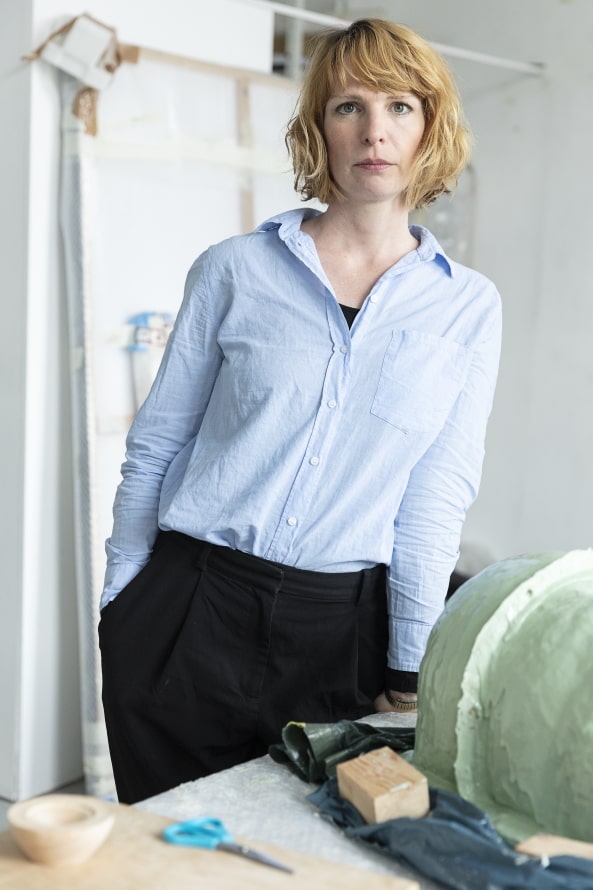Prologue | Personal
Mrs. Musolf, imagine if the pandemic did not dominate our lives at the moment and we could meet in your home or in your studio. Where do we talk together? In my studio. It is a beautiful, big and very bright room with ceilings 5 meters high. It’s situated in the 3rd floor of a school building of the former German Democratic Republic (in German: DDR, in English: GDR) in Berlin, in between the triangle of the quarters Kreuzberg, Neukölln and Alt-Treptow. In previous times the studio used to be a classroom and in the stairway of the house you can still see the typical GDR-style mosaics and wall paintings showing youth at work. In my studio you will find several tables, a big one for ‘thinking’ and paperwork, a smaller one with molds, Acystal, concrete and tools – and another one for weighing materials and devices for wax boiling. Maybe we are sitting at your favorite place? We are sitting at the big table looking out the window with view to the Kindergarten opposite the street. You can hear the children playing loudly and joyfully in the garden. It’s peaceful. Where do you come from, where were you born when? I am from northern Germany, Niedersachsen. I was born in Hannover in 1980.However, my soul feels French.
Image above: Portrait, 2019 Foto: © Dr. Cordia Schlegelmilch
Where do you currently live and work? I live in Berlin, I work at home and in my studio. And I am a teacher of Fine Arts and German language at a private school which offers a special progressive concept to the pupils. Which stations and people have shaped you? For sure my childhood and youth in a small town. Then Paris. After having finished secondary school (German Abitur) in the year 2000, I went to a suburb of Paris working as Au-Pair which means I had to take care of 3 children of a well-off French family. While the kids were at school, I went to the city of Paris and took courses in French literature and phonetics.
The long stolls through the town, looking at famous monuments and statues, walking in the gardens influenced my life and soul deeply.
After my year in Paris I went to Braunschweig to study Fine Arts. This was a very important time in my life. You were free to do what you wanted. Nobody told you what was right or wrong. We danced barefoot in the artist’s workshops, smoked on the roof and prepared meals with our professors Raimund Kummer and Bogomir Ecker. You were free to come and go as preferred. Too, I was influenced by my professor in educational science, Reimar Stielow. He never sticked to the planned time of his courses, sometimes we stayed 6 hours in one exhibition, and again and again we had to write down our ideas concerning the artwork shown.
In 2005 I went to Nice for one year. BAM! That was the total freedom of my mid-twenties.
Rock’n’Roll, no furniture in the apartment, lots of red wine and city tours with the ramshackle Diane of a friend.
The art academy of Nice, Villa Arson, situated on a hill is an architectural highlight because of its sculptural, nearly brutal construction with studios and terraces offering a view to the seaside.
However, teaching at the Villa Arson was structured in a quite paternalistic and hierarchic way, our professors were hard critics and seemed to be sacrosanct. The person that impressed me most was Noël Dolla, who tries to find the essentials in a minimalistic kind of art.
Then I learned that Candice Breitz had followed the call to teach in Braunschweig and I had to decide whether to acquire a diploma at the elite academy in France or in Braunschweig with Candice. I decided for Braunschweig an became a full member in her initial class. She asked a lot and gave a lot. She always tried to find out what YOU were searching for in your artwork. She was brilliant in exploring and reflecting your deepest intentions and in parallel offered 0ther perspectives together with 10 referring texts together with an impressive historical spectre. With her we travelled to New York, Luxembourg and Berlin. She allowed us to be part of her fast professional life as a globally acting artist giving speeches, organizing exhibitions, openings and productions.
Then, I met my man.
During the last phase of my studies the communication with Jean-Christophe Amman strenghtened me. We sent postcards to each other and from time to time I came to see him in his Frankfurt apartment. We talked about many things and, of course, about my artwork in which he was really interested in. Since he passed away I miss him.
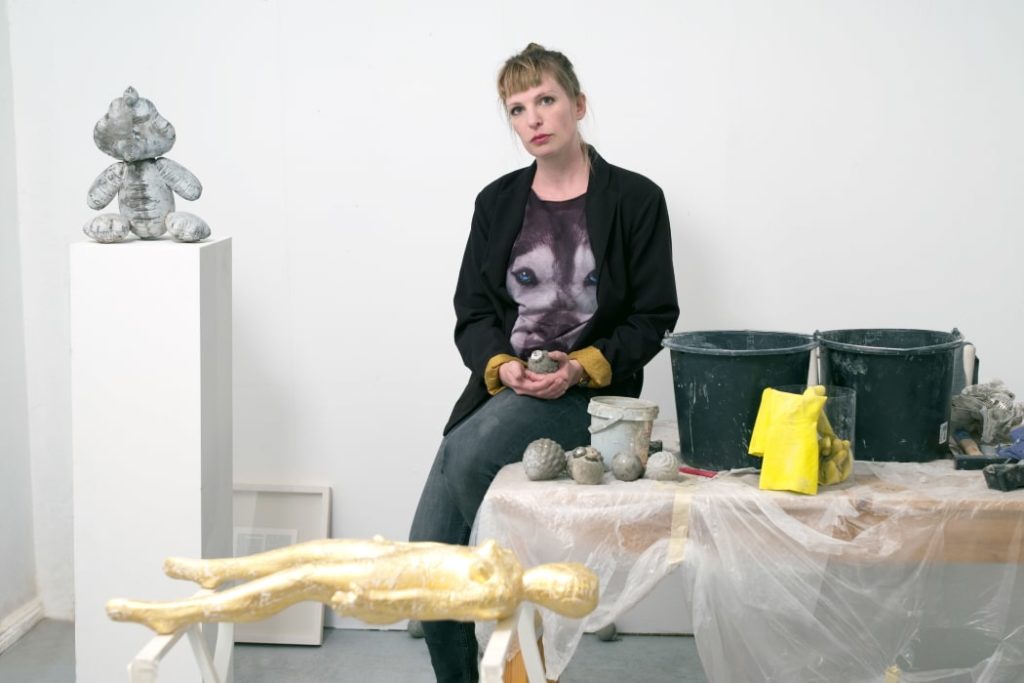
Which writers do you currently find exciting and which books are on your bookshelf? Benoîte Groult, a French feminist. I just discovered her book “Les vaisseaux du cœur” which was a scandalous success In the 1980ies. An incredible love story about physical passion written from a woman’s perspective. An intellectual young woman and a young fisherman get to know each other and will be connected for a lifetime. The two of them never live together, are married to different partners and have no common children. Yet every some years they meet on an island or elsewhere in the world just to make love. In this novel, aging, death and loss play a central role. Which books have influenced or shaped you? Franz Kafka: “Der Prozess”, Thomas Mann: “Tod in Vendig”. Novels of Michel Huellebecq, Patrick Süskind, Bernhard Schlink. The theories of Rousseau, Baudrillard, Laurie Penny, Zižek.
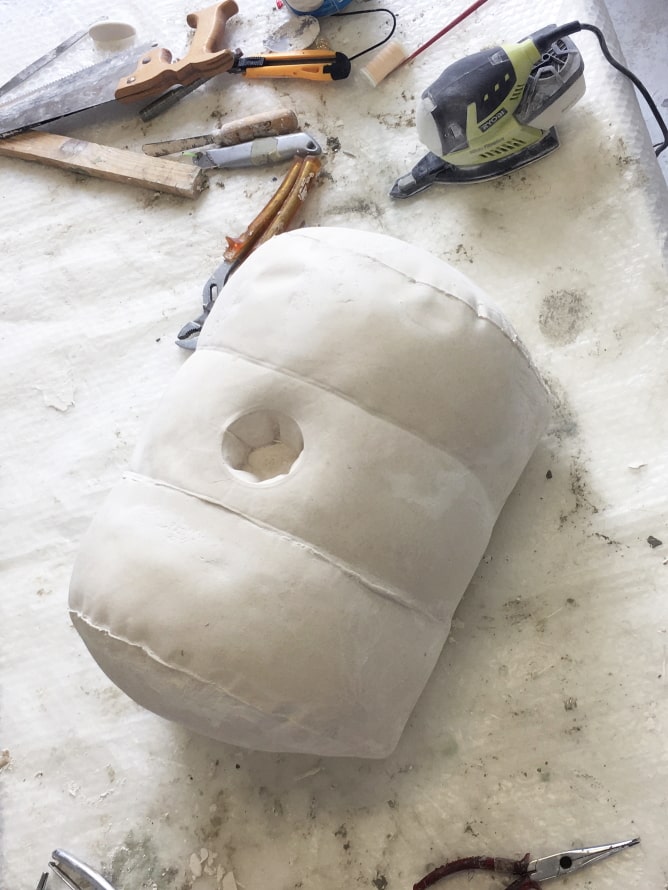
What are you currently reading and where do you keep the book? Virginie Despentes: “Das Leben des Vernon Subuteux”. You can find it either near my bathtub or on my bedside table. In preparation for my lessons at school I read Goethe: “Iphigenie auf Tauris”. What music do you listen to and when? I like the Spotify playlist of deutschlandfunk. In these days, the new single “Chemtrails over the Country Club” by Lana del Rey is one of my favourites. If you would cook something for us, what would it be? Chicorėe (endives) with Roquefort and walnuts, followed by a quiche and for dessert home made mousse au chocolat. What do you like to eat most?I love potatoes in the skin with sour cream, enriched with fresh herbs and a salad. What do you think about breakfast? Café, clope…no. Honestly, I love to breakfast and I need it to have a good start of the day. What kind of sport or counterbalance to your work do you practice?Cycling and yoga. Do you have special passions (hobbies) for which you are burning, and if so, which ones?I love to play with my five-year-old daughter. What personality trait defines you? I am not a great pretender.
Interview | Artist + Position
To begin, please tell us your artistic vita in a few sentences.
I enrolled at HBK Braunschweig, there had courses with Bogumir Ecker and Candice Breitz, in between one Erasmus-year at Villa Arson, Nice, later master student with Candice Breitz. After my exam I worked as artistic-scientific employee at HBK Braunschweig and held lectures in Halle, Burg Giebichenstein. Exhibitions, speeches and public talks with diverse artists.
Briefly explain your current project or the upcoming exhibition.
Presently I create a new homepage with professional photographs of my work.
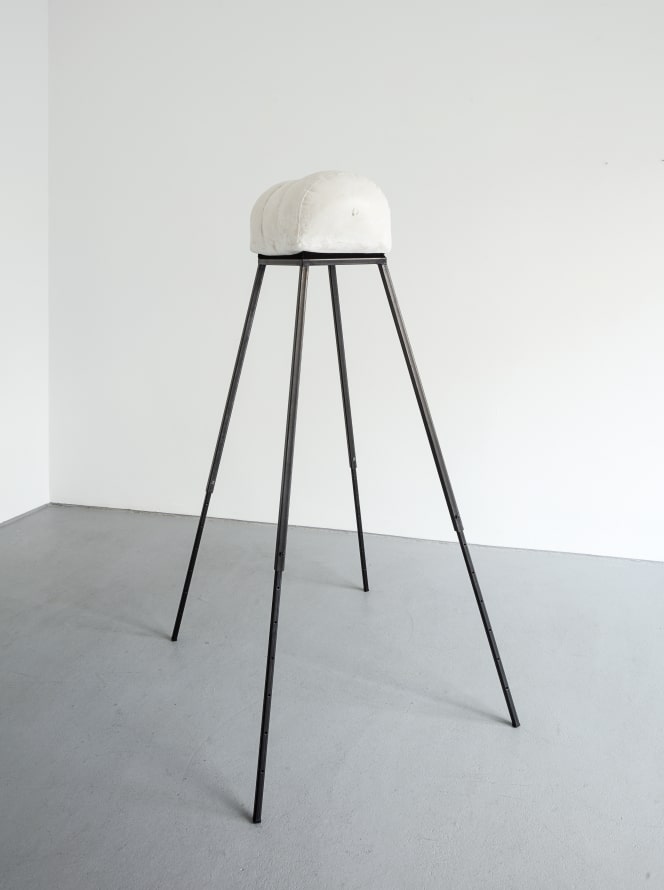
What are you most concerned about at the moment; what is on your mind?
It’s the pandemic. We are confronted with the fragility of our lives and our certainties. The pandemic brings back memories of persons you used to know, you think about the past and the future. We are driven to step down into our self.
How did you come to art? Why art?
I was a toddler when my mother began to take me to museums and exhibitions. A connection to art has some sort of tradition in our family. When I was teenager, artwork allowed me to retreat into non-defined categories where I was able to deal with my uncertainties and disaccords concerning my understanding of the world.

What makes you happy at the moment?
Real encounters. The lough of my daughter.
What is currently scaring you?
The state of our world as it is. It’s obvious we need new economic and social models and that we can’t carry on in the old ‘normal’ way. Yet, what are the alternatives?
Do you believe that art has a social responsibility? And what do you think it can do?
In my opinion everybody has social responsibility. For me it makes no difference if somebody is baking bread or doing art. And here I totally agree with Beuys.
Everybody is an artist insofar as the meant person can use her/his inventive ability of thinking as a creative potential, unfold it, use it and thus consciously create the world.
This is the opposite of thoughtlessness and implies a social process of change. For me, the preoccupation with art is closely tied to the thinking and acting which represents the humanistic ideals of classicism.
What makes your art special? What is it about – what are the central themes of your work?
It’s about toys and other consumer items which serve as a metaphor for the tangible substitution of human affection and the soulless machine that produces these things. It’s also about sex. I see my work all in one playful, brutally, real, funny, absurd and deadly serious. I ask myself which social evolution and symptoms can be read from the surface, from the form and from the material.
What is hiding beyond the air-filled shell of a toy or which abyss can be found behind the optimized and idealized picture of a photo model?
THE DEED | DAS WERK: Iris Musolf
The Hannover-born artist Iris Musolf, who lives and works in Berlin, talks about the central message of her artistic work during her interview.
Please describe the core theme and the central message of your work.
Concerning the creative process the question for me is how to make visible social and psychological qualities, how to show human depths and deformation but also a moment of surprise by using unexpected material.
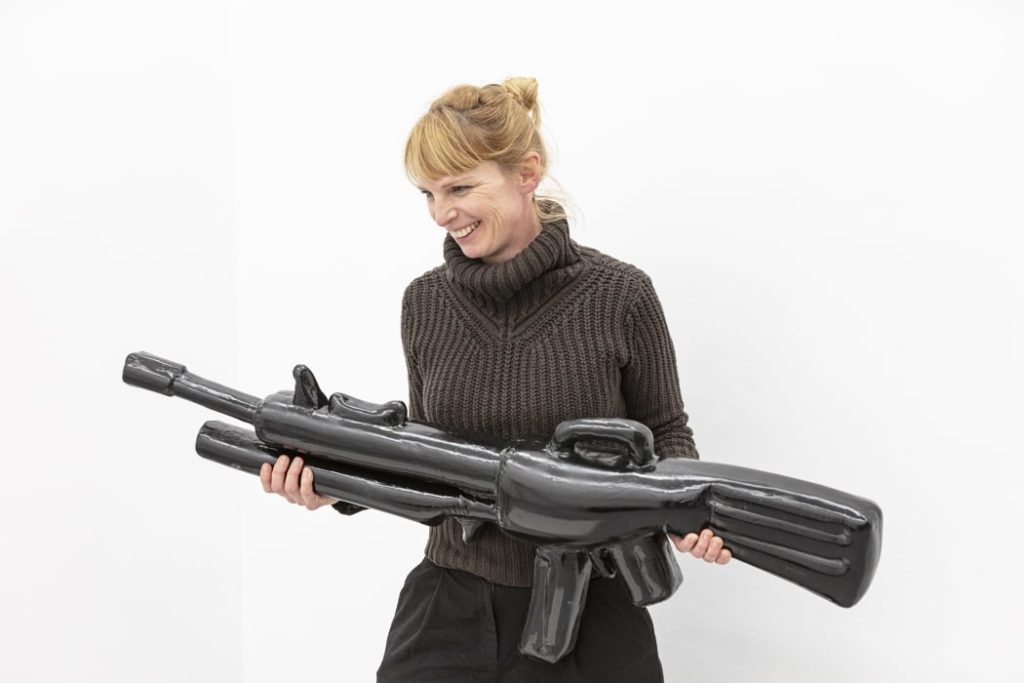
My central issues are trivial promotional and throwaway articles, optimized and cheap plastic surfaces, superficial fun, the marketing of sex without emotional engagement, colorful pictures. By using special material and forms I try to add some kind of gravity to these dazzling symbols of ease and superficial consumption, which, at a closer look, leads to ad absurd-um and finally dissolves. The question for me is: how must I change the visual presence to achieve a change in perception so that something of the inner nature of the work emerges?
Introduce us to the work that, in your view, exemplifies or best embodies the message of your work.
Inflatable sex-animals made of concrete, this is the combining of joke articles and a masochistic mental figure.
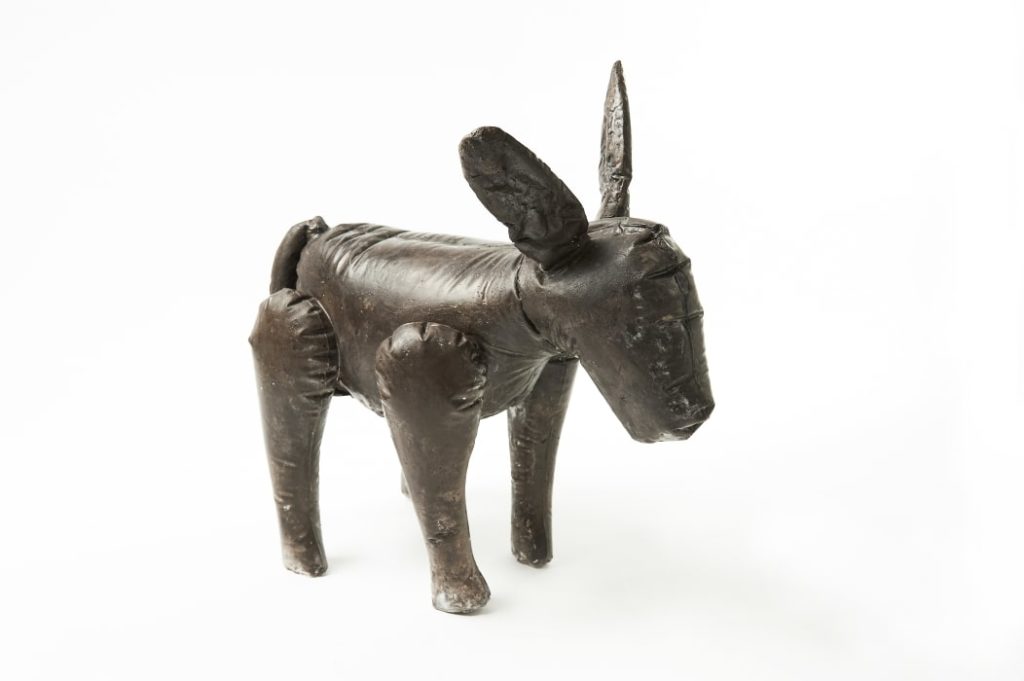
Imagine an inflatable rubber doll. Besides rubber dolls you can also buy inflatable plastic animals with anus holes to allow penetration: donkeys, pigs, cows, chicken. I set them in concrete.

My work “Springbock” is kind of follow-up. The “Springbock” is a frame that reminds you of a gymnastic equipment buck, but it is far too skinny and high to jump across.

On the buck I installed an inflatable, penetrable sex cushion made of marble Acrystal.

Another project was the “Gelbe Kabine” I built for the Federal Office for Radiation Protection. This gondola is a remake of a Ferris wheel gondola in the Chernobyl amusement park.
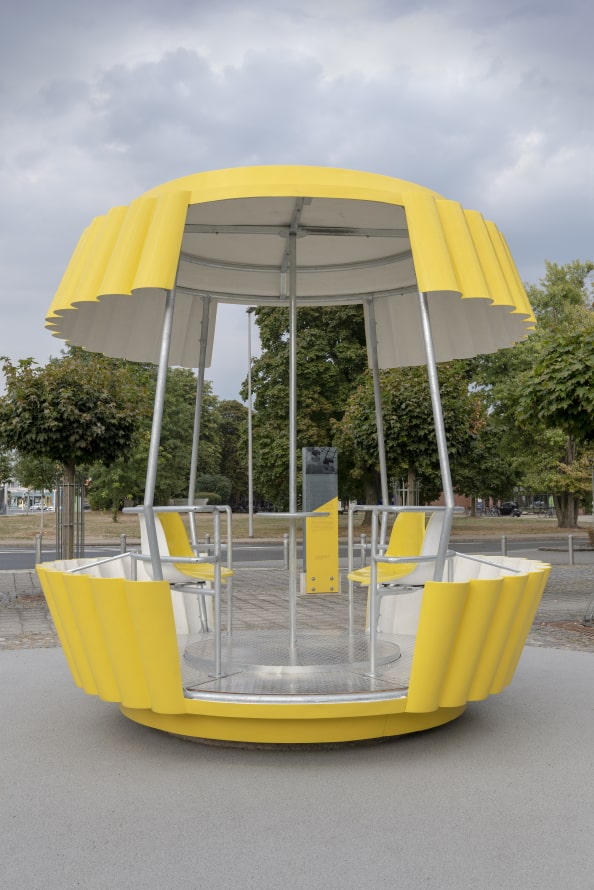
In normal life the gondola promises fun and joyful play, laughing children, but here, in open space this gondola is a symbol of one of the biggest technical catastrophes of mankind – the accident at the Chernobyl nuclear power plant in 1986.
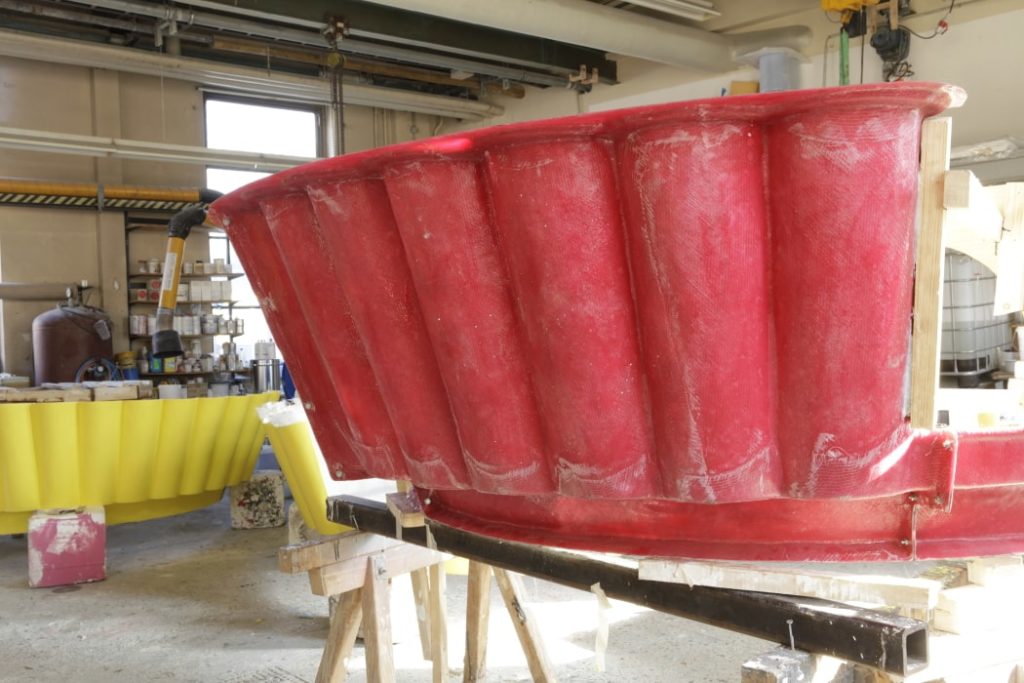
Herstellung der Arbeit „Gelbe Kabine“ bei sculptureberlin 2018
Foto: © Dr. Cordia Schlegelmilch
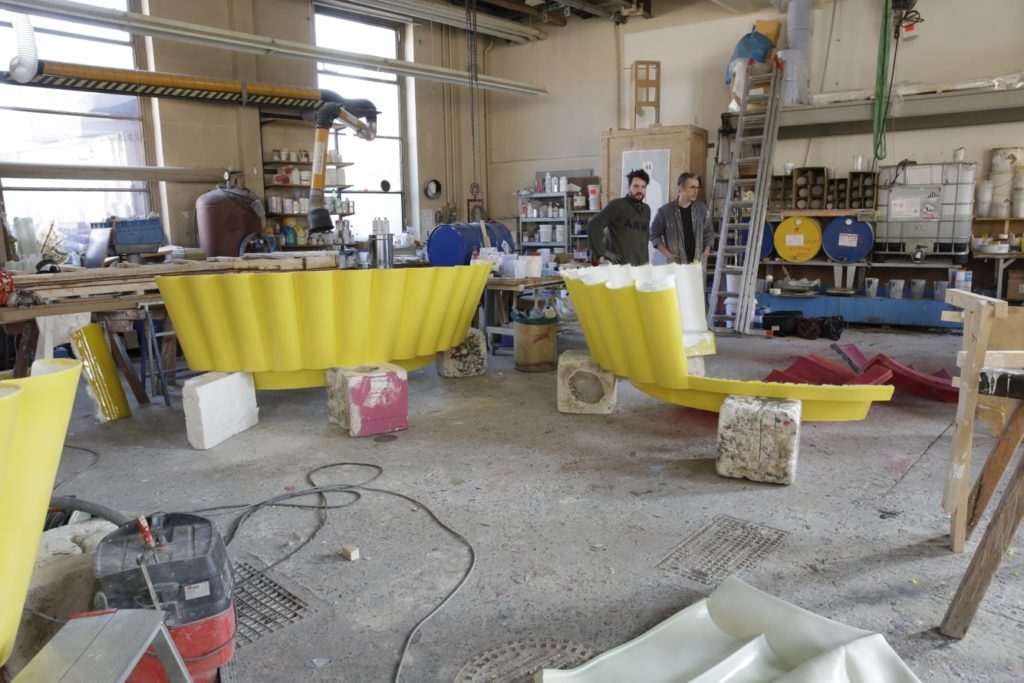
For me, there is no separation between pleasure and consumption and what it is made of. In art I have the opportunity to put together what I skip or can’t think clearly in words. I try to cast these ambivalences into a form.
I hope that I will succeed as for example did Martha Rosler with her series “Bringing The War Home” or Oliviero Tascani who photographed Jesus Jeans and the Benetton Campaign
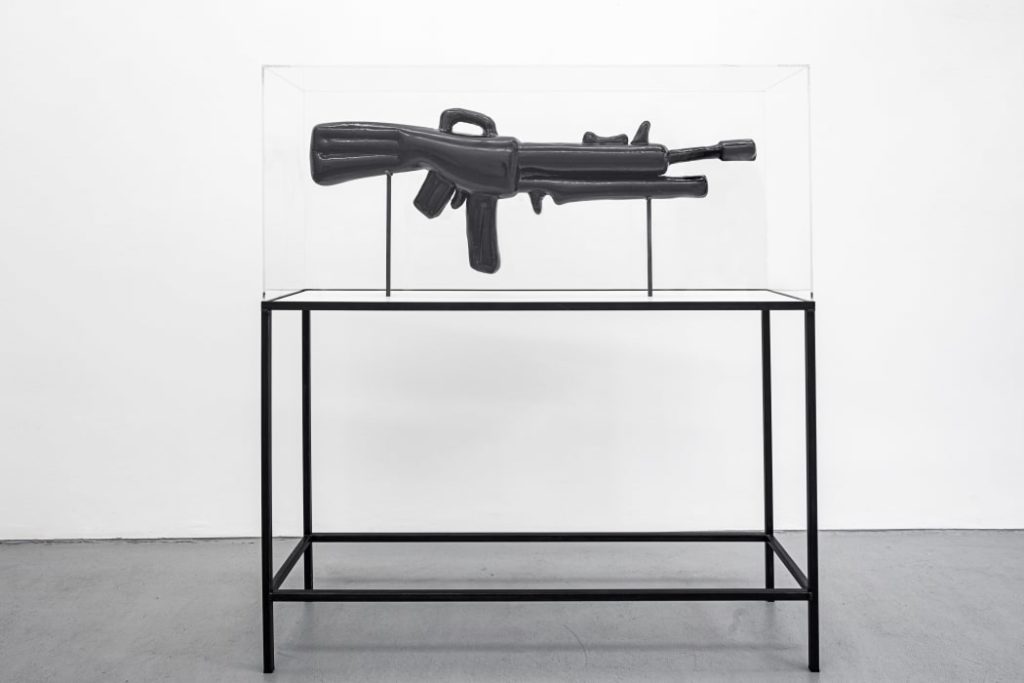
What is the aim of your art, your work, what is it supposed to achieve in the viewer?
I don’t have the power about the viewers thoughts. I hope that – from time to time -visions of my work will emerge before the inner eye of the people who know my art.
THE DEED | THE WORK is a complementary and separately presented part of THE INTERVIEW IN|DEEDS with Iris Musolf.
How do you protect yourself from too much inspiration these days?
I don’t follow the mainstream, I prefer a walk in the forest.
How much in your works is planned in advance – how much is created intuitively?
It depends. Sometimes it’s a play. But when it comes to a contest for art-in-architecture or open space, everything is planned, from the RAL-definition of color to the cost calculations of the companies involved. Sometimes I am just drifting and do something like moving paper scraps to and fro.

What are your (next) goals?
I’d like to develop a series of smaller publications in form of booklets to accompany and explain my work. Over the long term, this series could be carried on continuously.
What is your opinion about faith? Do you have principles of faith or is there a motto?
I don’t know if God exists, but I believe in a force that keeps everything together and that is stronger than mankind. And if this force is called God, it’s fine for me.

Photo: © Marion Schmiding & Alexander Ludwig Obst
Which project would you still like to realize, if lack of time, courage or financial resources would not play a role?
A bouncy castle for kids – made of concrete.
What do you consider to be attributes of good art?
If pieces of art stay in our physical memory (so stated by Amman) they are good. They trigger something deep inside of us we cannot explain, they shake us up. They brand into us, because they know that there is something inside us we didn’t know yet.
Is one born as an artist? Or is studying art compulsory in your view?
To study at the art academy is very special. In retrospect I don’t want to miss this experience and this view to the world. The art academy is a place where certainties vanish, where you are forced to reflect yourself and have to search for the essentials, search for what you want. On top, you have to cast all that in an expressive form!
For you as a student the contact with very intense characters and meetings in small groups is a quite formative experience. Everyone knows everybody. For me the art academy was a place where the unfiltered communication is possible, nothing was pressed into methods or pedagogical concepts. Some students won’t bear this way of teaching because it causes a conflict in comparison to school and the expectations learned. A lot of them quit the academy.

To whom do you show a new work first?
To my friends.
What does the first hour of your day look like?
The first hour is dedicated to the family. Leave bed, make coffee, make breakfast. Dress the kid, bring her to the Kindergarten.
in Times of the internet of things, are galleries still necessary? If so, why and what for?
Absolutely! If we just emphasized the necessities we could get rid of nearly everything. Galleries are experimental spaces where visitors really get into touch with art and thus make art to living objects. The gallery owner does not only offer space to exhibit artwork. The gallery as a market place is also important to show the value of artwork when it comes to buying or selling a piece. “Crypto-Art” is an interesting field, but I can’t deal with it- not yet.
Social-Media – a blessing or a curse?
“Es gibt nichts umsonst.”

Epilogue | Current
The solo exhibition Bockspringen with sculptures and collages by Iris Musolf has been shown from 7th November to 11th December 2020 at the Galerie Gilla Lörcher | Contemporary Art, Pohlstraße 73, 10785 Berlin-Tiergarten.
In times of Corona, when travel, studio visits and personal contacts are inappropriate or even impossible, the written interview remains an important medium to introduce artist personalities, to spread their messages and to stay in touch with art lovers. The interviews are not edited or shortened by the editors and are always reproduced in original sound. Therefore, we do not translate the interview into English or German, unless this is submitted by the interviewee.


